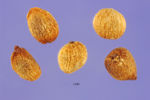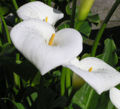Calla lily
| Calla lily |
|---|

|
| Scientific Classification |
|
| Species |
|
Calla Lilies are tender, herbaceous and aquatic, they are deciduous perennials and are native to South Africa. They mainly grow for their attractive, large flower spathes, which are usually produced in the spring and summer. Calla Lilies or also known as Arum Lilies, as they are commonly known, are grown in large quantities by commercial growers because they are most commonly used for decoration at Easter and throughout the spring and early summer months. This plant was introduced to Europe early on. [1]
Anatomy
The striking arum lily "flower" is actually many tiny flowers arranged in a complex spiral pattern on the central column. The tiny flowers are arranged in male and female zones on the spadix. The top 7 cm are male flowers and the lower 1.8 cm are female. If you look through a hand-lens you may see the stringy pollen emerging from the male flowers which consist largely of anthers. The female flowers have an ovary with a short stalk above it, which is the style (where the pollen is received). The spadix is surrounded by the white or coloured spathe. According to Marloth, the whiteness of the spathe is not caused by pigmentation, but is an optical effect produced by numerous air spaces beneath the epidermis. [2]
Reproduction
The stamen is the male part of a flower and has an anther on a stalk. The anther’s job is to produce the pollen. Then there is the pistil, or also known as the female part. The pistil contains the flower’s ovary, the style, and the stigma. Inside the ovary are the ovules. Each ovule contains an egg cell. So when an egg cell joins with a pollen cell, a seed may be produced. The ovary is at the base of the plant. The stigma is at the top, and between them is the style. So, the pollen from the anther has to land on the stigma. When that happens, the pollen germinates and makes its way down into the ovary. Then the ovary becomes a fruit. So a fruit is a mature ovary holding the seeds.[3]
Ecology
Calla Lilies are native to New Zealand and are originated in South Africa. They are usually found in Swampy areas and damp wasteland. Calla lilies grow naturally in marshy areas and is only deciduous when water becomes scarce. It grows continuously when watered and fed regularly and can survive minor frosts. Calla lilies are found in moist areas in the Pacific Northwest. [4]
Gallery
Related References
- Zantedeschia Wikipedia
- zantedeschia Botany
- zantedeschaeth Plants of africa







